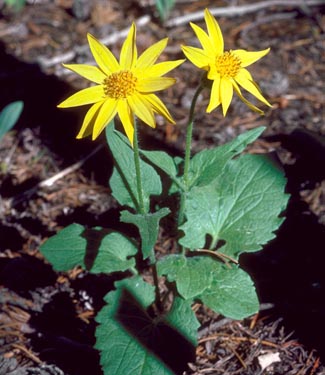Heartleaf Arnica

Common Name(s):
Heartleaf Arnica
Heart-leaved Arnica
Scientific Name:
Arnica cordifolia Hook.
Scientific Name Synonyms:
Arnica hardinae St. John
Arnica humilis Rydb.
Arnica paniculata A. Nels.
Arnica whitneyi Fern.
Symbol:
ARCO9
Description:
Life Span: Perennial
Origin: Native
Season: season goes here
Growth Characteristics: Heartleaf arnica grows 6 to 24 inches tall, with upright stems arising singly from long, slender, creeping rhizomes, which grow laterally 0.4 to 0.8 inches below the soil surface. The lifespan of heartleaf arnica is estimated at 12 years. It reproduces by wind-dispersed seed as well as through rhizomes. If flowers May through September.
Flowers: 1 to 5 flowering heads per plants. Yellow ray and disk flowers. 10 to 15 ray flowers.
Fruits/Seeds: 6-10 mm, short forked-hairy or glandular. The pappus is short barbed and whitish.
Leaves: Simple, opposite, petioled pairs of leaves becoming reduced as you move up the plant. The blades are 3-11 cm, strongly heart shaped, and generally shallowly toothed.
Stems: Upright
Ecological Adaptions:
Heartleaf arnica is a dominant ground cover in many forest communities of the west. It has low resistance to repeated human trampling. It occurs in boreal and cool temperate climates, and is commonly found in open-canopy coniferous forests on high elevation water-shedding sites, at elevation of 5,000 to 11,000 feet. Heartleaf arnica is tolerant of both sun and shade, it is moderately fire resistant, typically sprouting from surviving rhizomes after fire.
Soils: Often inhabits exposed, moderately dry mineral soils, but occurs on a variety of soil types.
Associated Species: Lodgepole pine, Douglas fir
Uses and Management:
In northern Utah, heartleaf arnica is an important constituent of summer diets of mule deer and elk. It increases substantially when trees are thinned which it grows beneath.
Traditionally, the plant was mashed and applied externally to swellings, cuts, and bruises.

